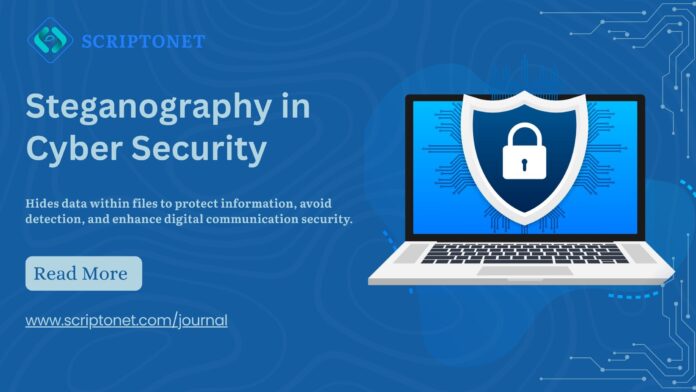Introduction
Steganography in Cyber Security is the art and science of hiding messages or information within seemingly harmless carriers, like digital photos, audio files, or even plain text documents.. It works on the tenet of concealing information in plain sight, such that untrained eyes cannot discover the existence of the secret message. Steganography aims to hide the message’s very existence, in contrast to encryption, which changes data into an unintelligible format.This is achieved by subtly altering the carrier file, often by making imperceptible changes to its least significant bits or by embedding information within the file’s metadata.The objective is to establish a line of communication that seems typical in order to prevent suspicion and detection.
The applications of steganography are diverse, ranging from secure communication & covert operations to digital watermarking & intellectual property protection. It can be used to transmit sensitive information without raising red flags or to embed copyright information within digital media. Furthermore, it can be utilized in conjunction with encryption, creating a layered security approach where the message is both hidden & scrambled. However, it’s important to recognize that steganography can also be misused for malicious purposes, such as concealing malware or distributing illegal content. Therefore, it’s a field that requires careful consideration of ethical implications & responsible use.
Types of Steganography
Steganography, the art of hiding information within other seemingly harmless data, manifests in several distinct forms, each leveraging different media & techniques. Changing the format of text files is the most basic type of steganography. This can range from altering whitespace between words & lines, subtly changing font characteristics, to employing invisible characters like zero-width spaces. The goal is to embed secret messages without significantly altering the text’s appearance or functionality, making it blend seamlessly with ordinary documents. Though simple, text steganography often has a limited capacity for hiding large amounts of data & can be susceptible to detection if the manipulations are not subtle enough.
Moving beyond text, image, audio & video steganography utilize the inherent redundancy in multimedia files. Image steganography, for instance, embeds secret data within the pixels of an image, often by modifying the least significant bits of color values. Because these changes are typically imperceptible to the human eye, the image appears unaltered, effectively concealing the embedded information. Similar to this, video steganography uses the vast amount of data included in video files to hide information inside the frames, while audio steganography uses methods like phase coding or audio sample manipulation to hide messages within sound recordings.These methods offer greater capacity for hiding data compared to text steganography & are widely used due to the prevalence of multimedia files.
Finally, network steganography operates at a more sophisticated level, hiding information within network traffic patterns. This can involve encoding messages in packet headers, manipulating the timing of packet transmissions or embedding data within network protocols. This form of steganography is particularly challenging to detect, as it blends in with normal network communication, making it a powerful tool for covert communication & data exfiltration. However, it also requires a deep understanding of network protocols & can be more complex to implement compared to file-based steganography. Each type of steganography provides a unique approach to concealing information, offering varying degrees of security, capacity & complexity & finding applications in diverse fields from secure communication to digital watermarking.
Techniques Used in Steganography
Steganography employs a variety of techniques to conceal information within carrier files, each tailored to exploit the specific characteristics of the chosen medium. One fundamental technique is Least Significant Bit (LSB) insertion, commonly used in image & audio steganography. This method involves replacing the least significant bits of pixel or audio sample values with the bits of the secret message. Because these bits contribute minimally to the overall image or sound quality, the changes are often imperceptible. Another common approach is masking & filtering, which hides information by marking specific areas of an image or audio file. These areas are chosen because they are less likely to be noticed, such as complex textures in an image or high-frequency components in an audio file. Additionally, techniques like transform domain steganography, which include methods like Discrete Cosine Transform (DCT) & Wavelet Transform, convert the carrier file into a frequency domain representation before embedding the data, making it more robust against certain types of attacks & image processing.
Furthermore, steganography techniques extend beyond simple bit manipulation to more complex methods involving statistical & linguistic approaches. Statistical steganography analyses the statistical properties of the carrier file & modifies them in a way that encodes the secret message. For instance, it might alter the distribution of pixel colours or word frequencies. Linguistic steganography, specifically for text, utilises the inherent redundancy of natural language. This can involve replacing words with synonyms, altering sentence structures or using grammatical variations to encode information. These linguistic manipulations are designed to be subtle, making the text appear natural while concealing the hidden message. Moreover, techniques like spread spectrum steganography, originally developed for military communications, spread the hidden data across a wide range of frequencies within the carrier signal, making it difficult to detect & extract without knowing the specific spreading code.
Finally, advancements in steganography have led to the development of techniques that leverage cryptographic principles & adaptive algorithms. Cryptographic steganography combines steganography with encryption, where the secret message is first encrypted & then hidden within the carrier file. This provides an extra layer of security, as even if the presence of the hidden message is detected, it remains unreadable without the decryption key. Based on the properties of the carrier file and the secret message, adaptive steganography algorithms dynamically modify the embedding procedure. These algorithms can optimize the hiding process to maximize capacity while minimizing the risk of detection. Techniques like Pixel-Value Differencing (PVD) & edge-based steganography focus on hiding data in areas of an image that are more resistant to distortion, such as edges & areas with high colour variation. These sophisticated techniques ensure that steganography remains a challenging field for detection & analysis, adapting to new threats & advancements in detection methods.
Applications of Steganography in Cyber Security
Steganography plays a multifaceted role in cybersecurity, offering both defensive & offensive capabilities. In defensive contexts, it can be used for covert communication & data exfiltration, particularly in environments where traditional encryption might raise suspicion. For instance, sensitive information can be embedded within seemingly innocuous images or audio files & transmitted across networks, bypassing Firewalls & Intrusion Detection Systems (IDS) that primarily focus on encrypted traffic. This allows for discreet communication between remote teams for the secure transmission of confidential documents. Furthermore, steganography can be employed for digital watermarking & intellectual property protection. Embedding copyright information or unique identifiers within digital media can help track unauthorized distribution & prove ownership, acting as a deterrent against piracy & data theft.
On the offensive side, steganography can be exploited by malicious actors to conceal malware or exfiltrate stolen data. Malware authors can embed malicious code within image or audio files, which are then distributed through seemingly legitimate channels. Once opened, the carrier file executes the hidden malware, compromising the target system. Similarly, attackers can use steganography to exfiltrate sensitive data from compromised systems by embedding it within innocuous files & transmitting them across the network. This technique can be particularly effective in evading data loss prevention systems that focus on detecting known file types or patterns of data transfer. Steganography can also be used to create secret communication channels inside hacked networks, which enables attackers to keep control and access for an extended period of time without setting off alarms.
Beyond these direct applications, steganography also plays a crucial role in forensic analysis & incident response. Digital forensics investigators can use steganography detection tools to uncover hidden data within files or network traffic, potentially revealing evidence of malicious activity or data breaches. This can be critical in identifying the source of an attack, understanding the extent of data compromise & reconstructing the timeline of events. Moreover, steganography analysis can help identify & disrupt covert communication channels used by cybercriminals, enhancing the effectiveness of incident response efforts. As cyber threats continue to evolve, understanding & mitigating the risks associated with steganography remains a critical aspect of maintaining robust cybersecurity defenses & ensuring the integrity of digital information.
Conclusion
In conclusion, steganography in cyber security stands as a powerful, yet often overlooked tool. Its ability to conceal data within seemingly harmless carriers provides a unique advantage in various applications, from covert communication & intellectual property protection to malware concealment & data exfiltration. The diverse techniques employed, ranging from simple bit manipulation to complex statistical & cryptographic methods, highlight the adaptability & sophistication of steganography. As digital communication continues to evolve, the importance of understanding & addressing the implications of steganography will only grow.
Steganography’s dual nature, however, calls for a well-rounded strategy. While it offers valuable defensive capabilities, it also poses significant risks when misused. Therefore, robust detection & analysis techniques are crucial for maintaining cybersecurity. Furthermore, ethical considerations & responsible use are paramount to prevent the exploitation of steganography for malicious purposes. As technology advances, ongoing research & development in both steganography & steganalysis are essential to ensure the continued security & integrity of digital information & communication.
Frequently Asked Questions (FAQ)
What is the difference between steganography & cryptography?
Steganography conceals the existence of data, whereas cryptography jumbles it to render it unintelligible. While cryptography focuses on confidentiality, steganography focuses on concealment.
How secure is steganography?
The security of steganography depends on the technique used, the size of the hidden message & the sophistication of the steganalysis methods employed. Simple techniques can be easily detected, while advanced methods can be very difficult to uncover.
What are the common types of files used in steganography?
Common file types include images, audio files, video files & text documents. These files offer varying degrees of redundancy that can be exploited to hide data.
Can steganography be used for illegal activities?
Yes, like any technology, steganography can be misused to conceal illegal activities, such as hiding malware, distributing illicit content or facilitating covert communication between criminals.
How can steganography be detected?
Steganography detection or steganalysis, involves analyzing files for statistical anomalies or patterns that indicate the presence of hidden data. This can include examining pixel values, file sizes & other characteristics. Specialized tools & techniques are required for effective steganalysis.


